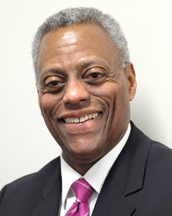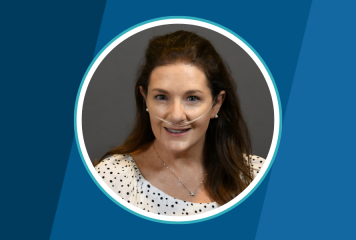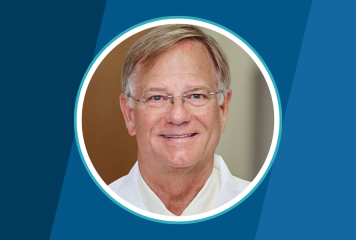
Jesse Milan Jr., JD, is the President and Chief Executive Officer of AIDS United, a national organization focused on ending the HIV epidemic in the U.S. through grantmaking, policy and advocacy, and capacity building. Mr. Milan is a member of the ABIM Infectious Disease Board. He took some time to talk to ABIM about the HIV epidemic, including what physicians should know and what is needed to realize “Getting to Zero.”
What is your history with HIV?
This year is my 40th year living with HIV. Last year was the 40th year since the identification of the human immunodeficiency virus (HIV) by the Centers for Disease Control and Prevention (CDC). That same year I graduated from law school, so my entire professional life has been framed by the HIV epidemic.
I lost my partner to HIV in the mid-1980s. Along the way, as a young lawyer in Philadelphia, I was called to do more and more in the community about HIV and to be a professional advocate and resource. I found that because of having lost someone to HIV and because of my legal experience, I could bring a unique voice to the community. I found myself in leadership positions in the Philadelphia community for HIV, culminating in becoming the director of the Office of AIDS for the City of Philadelphia. I met my husband 34 years ago where we were doing community work on HIV together.
My life story and journey have been framed both personally and professionally around HIV. That journey has led me to serving as chair of a number of boards and committees at the federal, national and regional levels, speaking about HIV on tours across Africa on behalf of the State Department, and today being president and CEO of AIDS United, whose mission is ending the HIV epidemic in the United States.
How did you become involved with ABIM?
A colleague of mine served on the Infectious Disease Board and when her term ended, she recommended me. I was quite surprised but thought, this is an amazing opportunity and if I’m selected I will be eager to serve.
What has been your experience serving on the Infectious Disease Board?
As a non-physician member, my role is to bring the patient and community perspectives to the work of ABIM. I try to do that not only through the lens of HIV but through the lens of broader public health and infectious diseases, including sexually transmitted infections that are far too prevalent in this country. In doing this work with ABIM, I’ve found that being a voice for the patient community and for the broader public health community has been a wonderful collaboration and that the members of the Infectious Disease Board appreciate hearing those perspectives.
What does ending the HIV epidemic look like?
Ending the HIV epidemic means there are no more HIV transmissions, that no one with HIV ever develops or dies of AIDS, and that all those living with HIV live a normal healthy lifespan. To achieve this we need the political will to appropriate the resources and build policies needed for ending the epidemic. It was only in the Obama Administration that we had the first National HIV/AIDS Strategy after 30 years of advocacy. After being dormant during the Trump presidency, that strategy was updated last year by the Biden Administration. Today we are still fighting to get the resources needed for ending this epidemic, and that fight has been compounded by the COVID-19 pandemic and the economy. We’ve had flat funding for more than ten years for addressing most aspects of HIV prevention, treatment and care and that includes support services, such as housing, which is critically needed. And we continue fighting the persistent stigma of HIV.
Our fight at the federal level is about the policies and appropriations needed for ending this epidemic. We continue to work against policies such as the ban on the use of federal funds for obtaining syringes in syringe exchange efforts. We are fighting to maintain the Affordable Care Act and expand Medicaid, particularly in the South where half of the epidemic exists. The states that have not expanded Medicaid are where a substantial number of people living with HIV reside. The failure of those states has significantly impeded our ability to end this epidemic.
What role do biomedical interventions play in ending the HIV epidemic? What else is needed?
Let’s praise the advances that have happened in medicine over the last 25 years: antiretroviral therapy (ART) is saving people’s lives by preventing HIV from destroying our immune systems to the point where we develop AIDS and die. That advance is truly wondrous. ART has become much easier to take, advancing from multiple pills to in some cases only one pill. Today we also have the advancement of injectables that can last two to six months. That is huge. These advances are truly miraculous. These have made it possible for people like me to never develop an AIDS-defining disease. On the prevention side we have preexposure prophylaxis (PrEP) which is essentially 100% effective at preventing people from acquiring HIV.
We have the biomedical tools we need to end this epidemic: On the treatment side, we can stop people from developing AIDS by helping them reach and maintain an undetectable viral load. But only about 50% of people with HIV in the U.S. have an undetectable viral load. On the prevention side, with PrEP we can prevent people from contracting HIV. In addition, if you achieve and maintain an undetectable viral load, your HIV is untransmittable. This is known as U=U (undetectable equals untransmittable). It is amazing news. With that scientific fact and all other medical advances, we literally have the tools we need to stop the epidemic. What we don’t have is a vaccine. We learned from COVID that a vaccine would be the best tool but an HIV vaccine is still proving elusive and it may be years away. In the meantime, we need political will to create policies and appropriations in order to get treatment and care for people living with HIV and to create a national program to get PrEP to people who are highly vulnerable to acquiring HIV. We also need policies and programs in place for an aging population. Today, half of all people living with HIV in America are age 50 or older. We have to prepare our senior services—including Medicare—for the increase of people living with HIV who will soon need those services
How can physicians contribute to ending HIV? What should more doctors know?
One of the conversations we are having on the Infectious Disease Board is whether there should be an HIV subspecialty certification that could be applied to physicians who are working in allied fields such as geriatrics, obstetrics and gynecology, family medicine, and even general practitioners. That would be helpful in under-resourced areas and rural populations that might not have an infectious disease specialist but might have a family medicine specialist, for instance. Having excellent, state-of-the-art HIV care is what’s needed for people living with HIV to get access to the medications that are best for them and to the medical advice they need, not only because of their HIV but because of comorbidities they face as they age.
We’re also talking about the HIV workforce, which does not comprise only physicians. The HIV workforce is nurses, nurse practitioners, pharmacist and community health workers, among others. The potential HIV workforce is large but the number newly joining or working today with an understanding of HIV is not as big as we need it to be in order to take care of the 1.2 million people living with HIV today or the additional 1.2 million people who are highly vulnerable to HIV according to the CDC.
What kind of health inequities impact people living with HIV?
We need to look at health inequities from different lenses. Racial health disparities have been persistent since the beginning of this epidemic. Those inequities encompass Black and brown men and particularly young gay men of color, Black women of all ages and Latinx communities, especially in Puerto Rico. Racial inequities have to be addressed if we are to end this epidemic.
We also have to address LGBTQ inequities. We’ve been aware of the impact on the gay community since the beginning of the epidemic but we’ve often left out the transgender community in our discussions about HIV. It’s critical that we change that because they are significantly and disproportionately impacted by HIV. The monkeypox epidemic has not helped LGBTQ disparities. Nearly half of all people diagnosed with monkeypox are gay men living with HIV, so inequities and disparities continue.
And of course, there is the regional health inequity regarding the South: half of all people living with HIV reside in the South; half of all new transmissions occur in the South. The South needs our federal support but our states in the South need to understand that they cannot ignore the HIV problem in their community because their policies—including HIV criminalization statutes and their failure to expand Medicaid—are fueling our national HIV problem.
What has changed in the last 40 years for people living with HIV?
The fact that 50% of people living with HIV are now age 50 and older—many like me have been healthy for decades. When I started this work, having HIV was without a doubt a death sentence, but it is not anymore. And today with PrEP we can truly stop all new infections. What’s also changed is that HIV is part of the bigger political and policy debate about health equity, health care costs, reproductive and sexual health and of course equal rights. Today we are more aware and concerned about the mental health issues faced by people living with HIV. And we should be very concerned about the continuing stigma and the continuing discrimination against people living with HIV. I’m surprised by the stories I hear today about the response people get when they share that they have HIV, both their fear to disclose and the reticence of people who are HIV-negative to publicly discuss and embrace people living with HIV.
Finally, what’s changing is a greater awareness in the health care community of the fact that we must understand our patients’ full lives in order to help them remain adherent to their regimens and stay in care. We must advance trainings in medical school and continuing education that are not only about the science of HIV but also about the society of HIV—the cultural and social issues, and the social determinants of health that impact the health and well-being of people living with and vulnerable to HIV.



